





 |
 |
 |
 |
 |
 |
|---|---|---|---|---|---|
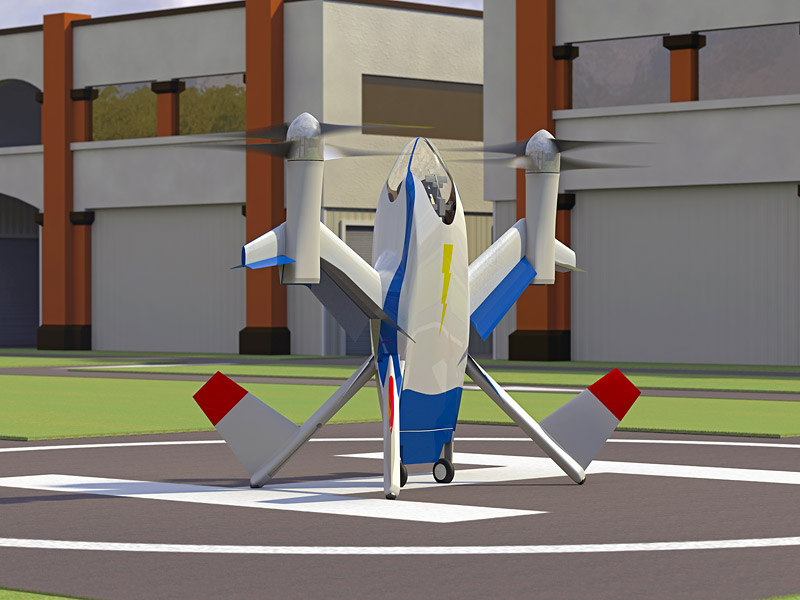 |
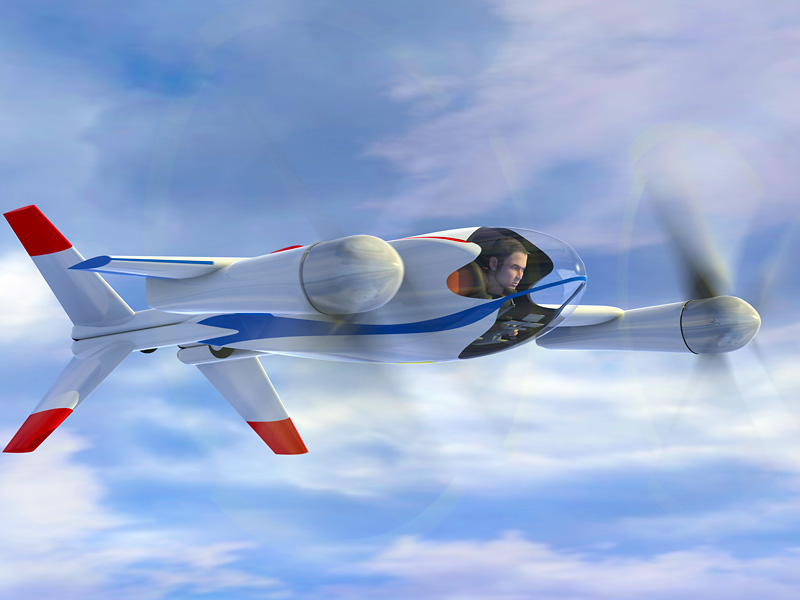 |
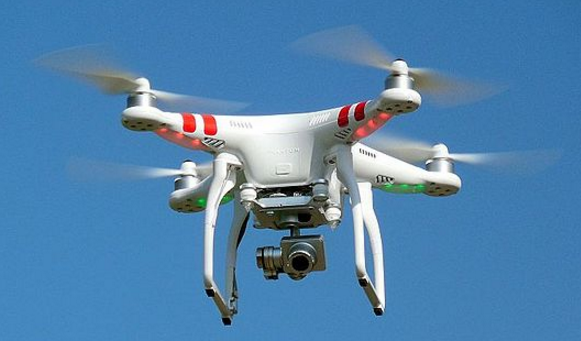 |
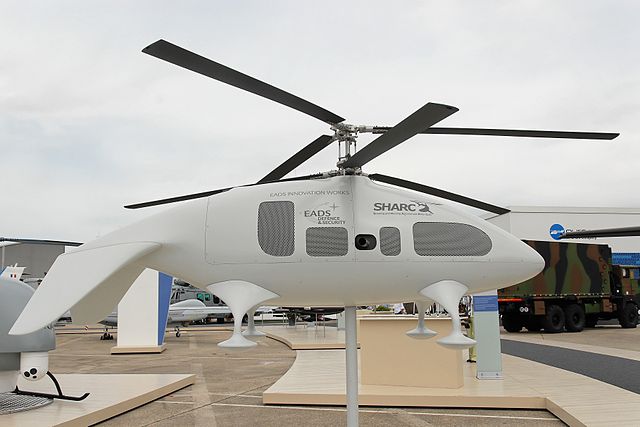 |
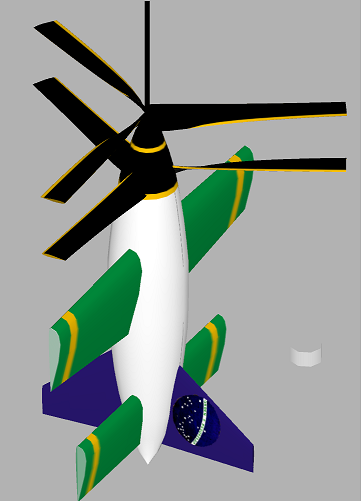 |
|---|---|---|---|---|
A electric propeller-driven aircraft can hover for more than an hour. The hovering time is determined by the battery energy per mass and by the rotor radius. Example values:
Drone mass = M = 1.0 kg Battery mass = m = .5 kg Battery energy/mass= e = E/m = .8 MJoules/kg Battery energy = E = .4 MJoules Hover power/mass = p = P/M = 94 Watts/kg (Hover power for a 1 kg drone with a 1/4 meter radius rotor) Hover power = P = p M = 94 Watts Flight time = T = E/P = 3990 seconds = 66 minutesThe flight time is
T = (e/p)⋅(m/M)
The power per mass required to hover is determined by the physics of rotors. For a 1 kg vehicle with a 1/4 meter radius rotor,
Mass = M = 1 kg Gravity constant = g = 9.8 meters/second Rotor radius = R = .25 meters Rotor quality = q = 1.3 Hover power/mass = p = M½ g3/2 q-1 R-1 = 94 WattsThe rotor radius scales as M1/3 and the hover power/mass scales as M1/6. If we scale the above vehicle from 1 kg up to 300 kg (the mass of a 1-person vehicle) the hovering power/mass is 240 Watts/kg and the total power is 73 kWatts, or 98 horsepower.
Energy/Mass Power/Mass Recharge Year Anode Cathode Market fraction of
MJoule/kg Watt/kg Lithium-ion batteries
Lithium air 6.12 No Future Li O2
Aluminum air 4.68 200 No 1970 Al O2
Lithium thionyl 2.00 700 No 1973 Li SOCl2
Zinc air 1.59 No 1932 Zn O2
Lithium-ion sulfur 1.44 670 Yes Future Li S 0
Lithium metal 1.01 400 No 1976 Li MnO2
Lithium-ion CoNiAlO2 .79 Yes 1999 Li CoNiAlO2 .10
Lithium-ion CoNiMnO2 .74 1200 Yes 2008 Li CoNiMnO2 .29
Lithium-ion CoO2 .70 200 Yes 1991 Li CoO2 .29
Lithium-ion Mn2O4 .54 1200 Yes 1999 Li Mn2O4 .10
Lithium-ion FePO4 .47 1200 Yes 1996 Li FePO4 .22
Alkaline .40 Yes 1992 Zn MnO2
NiMH .34 1000 Yes 1990 MH NiO(OH)
Lead acid .15 180 Yes 1881 Pb PbO2
NiCd .14 200 Yes 1960 Cd NiO(OH)
 |
|---|
Drone Battery Drone Battery Battery Drone Drone Flight Price Wireless
mass energy mass power time range
kg MJoule MJ/kg kg MJ/kg Watt W/kg minutes $ km
Mota Jetjat Nano .011 .00160 .145 3.3 303 8 40 .02
ByRobot Fighter .030 .0040 .133 6.7 222 10 120 .1
Blade mQX .0751 .0067 .089 11.2 149 10 115
XDrone Zepto .082 .0067 .081 4.6 56 24 40 .05
Walkera QR Y100 .146 .0213 .146 .0413 .52 17.8 122 20 100 .1
MJX Bugs 3 .485 .0480 .099 44.4 92 18 100 .5
DJI Mavic Pro .725 .157 .217 .24 .65 109 150 24 1000 7.0
XK Detect X380C 1.18 .216 .183 120 102 30 522 1.0
Xiaomi Mi 1.376 .319 .214 197 143 27 380 1.0
DJI Phantom 4 1.38 .293 .212 .426 .69 174 126 28 1000 5.0
XK X500 1.8 .288 .160 160 89 30 303 1.0
JYU Spider X 2.1 .360 .171 .812 .44 200 95 30 155 4.0
MD4-1000 2.65 1.039 .392 197 74 88 2000 .5
DJI Inspire 2.935 .360 .123 .67 .54 333 114 18 2000 7.0
Altura Zenith 3.5 1.327 .379 491 140 45 2000 1.0
Walkera QR X800 3.9 .799 .205 1.134 .70 222 57 60 2700 2.0
AEE F100 6.0 1.598 .266 380 63 70 58000 10.0
Chaos HL48 6.8 1.758 .259 651 96 45 20000 20.0
MD4-3000 10.4 2.80 .269 1037 100 45 4.0
Ehang 184 200 51.8 .259 37500 188 23 300000 3.5
1 MJ = 1 MJoule = 106 Joules
Electric power outperformes gasoline power in all categories except energy density. Electric motors are lighter, simpler, cheaper, more flexible, and more reliable than combustion motors.
Drone Battery Drone Drone Drone Flight Cost Wireless Wing Wing Cruise Max Flight
mass energy E/M power time range area span speed speed range
kg MJoule MJ/kg Watts W/kg minutes $ km m2 m m/s m/s km
Sky Hawk .355 .0346 .097 19.2 54.1 30 400 1.0 1.0
Chaipirinha .62 .088 .142 154 .85
AgDrone 2.25 .639 .284 161 71.7 66 4.5 .124 46.7 82 50
Trimble UX5 2.5 .320 .128 107 42.7 50 10000 2.5 .34 .10 80 60
Airbus E-Fan 450 104.4 .232 29000 64.4 60 9.5 44.4 61.1 160
Sun Flyer 1225
 |
 |
 |
 |
|---|---|---|---|
The properties of a flying car are determined by the properties of propellers and lithium-ion batteries. Typical parameters for a 1-person car are:
Hovering time = 25 minutes Cruise speed = 100 meters/second Range = 155 km Hovering power = 40 kWatts Vehicle mass = 320 kg Battery energy/mass= .8 MJoules/kg Battery power/mass = 1200 Watts/kg Battery cost/MJoule= 100 $/MJoule Battery mass = 80 kg Battery energy = 64 MJoules Battery power = 96 kWatts Battery cost = 6400 $
For hovering, the more rotors the better. The hovering time scales as rotor number to the 1/6 power. Adding rotors also increases stability and failsafe.
For a typical drone,
Drone mass = M Battery mass = Mbat Payload mass = Mpay Climbing speed = Vcli Max horizontal speed = Vmax Hover constant = H = 60 Watts/kg Power/mass required to hover Hover power = Phov= H M Hover power for payload= Ppay= H Mpay Gravity constant = g = 9.8 m/s Power to climb = Pcli= M g V Drag coefficient = C Air density = D = 1.22 kg/meter3 Drone cross-section = A Drag power = Pdrag= ½ C D A V3If the climbing power is equal to the hover power,
V = H / g = 6 meters/secondIf the climbing power is equal to the drag power,
M g V = ½ C D A V3 V = [2Mg/(CDA)]½ = 4.0 [M/(CA)]½ meters/second
Drone Battery Load Hover Load Climb Power P/M Climb Speed Thrust
kg kg kg Watt Watt Watt Watt W/kg m/s m/s Newtons
Nihui NH-010 .0168 .0047 - 6.7 6.7 1426 - -
Walkera QR Y100 .146 .0413 - 17.8 35.5 53.3 1291 - -
DJI Mavic Pro .725 .24 - 109 109 454 5 18
DJI Phantom 4 1.38 .426 .462 174 58 81 232 545 6 20
JYU Spider X 2.1 .812 2.3 200 219 103 419 516 5 8
MD4-1000 2.65 1.2 197 89 195 286 7.5 12 118
DJI Inspire 1 2.935 .67 1.7 333 193 144 526 785 5 22
AEE F100 6.0 2.5 300 380 28
Chaos HL48 6.8 6.8 651 651 1302
MD4-3000 10.4 4.6 1037 1019 1496 10 280
Ehang 200 100 37500 28
Drone kg Drone mass without payload
Battery kg Battery mass
Load kg Maximum payload for hovering
Hover Watt Power required to hover without payload
Load Watt Power used for the payload only
Climb Watt Climbing power = Mass * ClimbVelocity * Gravityconstant
Power Watt Total power = Hover power + Load power
P/M W/kg Power/Mass for the battery
Climb m/s Maximum climbing speed
Speed m/s Maximum horizontal speed
Thrust Newton Maximum thrust
The JYU Spider X has the largest value for (payload mass) / (drone mass). The
battery power/mass is
Battery power/mass = Phov ⋅ (M + Mpay) / M / Mbat = 516 Watts/kg
The properties of the best commercial lithium ion batteries are:
Energy/Mass = .8 Joule/kg Power/Mass = 1200 Watt/kg Energy/$ = .01 MJoule/kg Density = 3.5 gram/cm3 Recharges =1000 Shelf life = 1.0 year Voltage = 3.7 VoltEnergy/Mass and Power/Mass are an engineering tradeoff. One can be increased at the expense of the other.
Voltage = V Volts
Charge = C Coulombs
Time = T seconds
Electric current = I = C/T Amperes (Amps)
Electric power = P = VI Watts
Energy = E = PT Joules
= CV Joules
Battery energy is often given in "Watt hours" or "Ampere hours".
1 Watt hour = 3600 Joules = 1 Watt * 3600 seconds
1 Amp hour = 3600 Coulombs = 1 Coulombs/second * 3600 seconds
A battery with a voltage of 3.7 Volts that delivers
1 Ampere for 1 hour has an energy of
Energy = 1 Ampere * 3.7 Volts * 3600 seconds = 13320 Joules
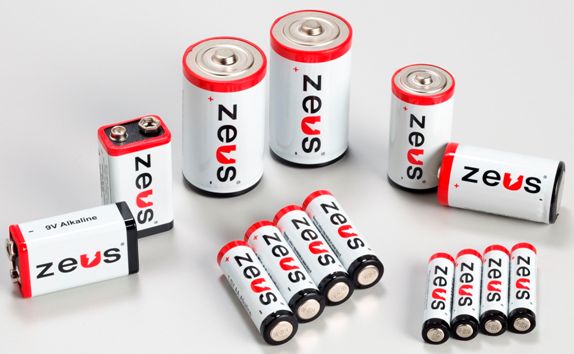 |
|---|
Energies and powers are for lithium batteries, which have a voltage of 3.7 Volts. The "ID #" is often used instead of cell size.
Cell Energy Power Current Mass Diameter Length Charge Price ID # size kJoule Watt Ampere gram mm mm AmpHour $ D 107 220 60 138 32 67 8.0 13 32650 C 67 220 60 92 26 50 5.0 8 26650, 25500 B 58 160 45 72 22 60 4.5 5 21700, 20700 A 47 110 30 49 18 50 3.5 3 18650 AA 9 22 6 15 14 53 .70 1 14500 AAA 4.7 11 3 7.6 10 44 .35 .5 10440 AAAA 2.3 6 1.5 3.8 8 42 .17 .25 75400 CR2032 3. Most common button cell CR1216 .33 Smallest button cell Apple Watch 4 4.0 .29 iPhoneXR 6" 41 2.94 Machine = .194 kg iPhoneXSM 6" 44 3.17 Machine = .208 kg iPhoneXS 6" 36 2.66 Machine = .177 kg iPhone8+ 6" 27 2.79 Machine = .202 kg iPhone8 5" 25 1.82 Machine = .148 kg iPhone7+ 6" 40 2.90 Machine = .188 kg iPhone7 5" 27 1.96 Machine = .138 kg iPad Mini 8" 70 5.12 Machine = .30 kg iPad Pro 10" 111 8.13 Machine = .47 kg Mac Air 11" 137 Machine = 1.08 kg Mac Air 13" 194 Machine = 1.34 kg MacBook 12" 149 Machine = .92 kg Mac Pro 13" 209 Machine = 1.37 kg Mac Pro 15" 301 Machine = 1.83 kg
Energy Power Lifetime
kJoule Watts hours
iPhone 8 5" 25 .50 14
iPhone 8+ 6" 27 .54 14
iPad Mini 8" 70 1.9 10
iPad Pro 10" 111 3.1 10
Mac Air 11" 137 3.8 10
Mac Air 13" 194 5.4 10
Mac Pro 13" 209 5.8 10
Mac Pro 15" 301 8.4 10
A single battery is a "cell" and a set of cells is a "pack". Packs are used to multiply the energy and power of cells.
Battery packs are notorous for catching fire, but cell technology has reached the point where it's now possible to make safe battery packs, and the design is simple enough so that anyone can construct their own packs.
Cells can be combined in series and/or parallel. Connecting in series multiples voltage, and voltage is helpful for achieving high power in a motor.
Connecting in series is easier than in parallel. If it's possible to achieve the required power without parallelization then one should do so, and this is usually possible with modern cells.
Series packs have the advantage that the cells can easily be extracted and charged individually, and cells can be interchanged between packs. One can also construct a set of series packs and swap them in like gun clips.
High power electric bikes use a voltage of 72 Volts. If we use one series array of C cells then a pack provides 4440 Watts and 1.2 MJoules. Any electric device requiring less than this much power can be powered by a series pack.
The properties of a modern high-power cell are:
Type = "C" Voltage = 3.7 Volts Energy = 60 kJoules Power = 155 Watts Mass = 92 grams Energy/mass = 650 kJoules/kg Power/mass =1680 Watts/kg Current = 42 Amperes Manufacturer = "Basen"When the cells are connected in series the values for voltage and power are:
Cells Voltage Power
Volts kWatts
1 3.7 .15
2 7.4 .30
3 11 .45 Electric kick scooter
4 15 .60
6 24 .90 Electric bike
10 36 1.5
20 72 3.0 Compact electric car
96 356 15.0 Large electric car
Size Charge Current Price
Amphours Amps $
Basen C 4.5 60 8.0
Panasonic B 4.0 15 8.0
Sony VTC6 A 3.0 30 8.0
Panasonic A 3.5 10 5.5
Efest IMR AA .65 6.5 3.5
Efest IMR AAA .35 3 3.0
Prices from www.liionwholesale.com
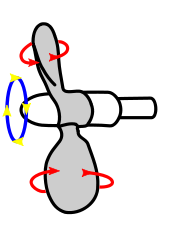 |
|---|
For propellers,
Rotor radius = R
Air density = D = 1.22 kg/meter3 at sea level
Rotor tip speed = V
Rotor width param= Cr
Rotor lift force = F↑ = D Cr R2 V2
Rotor drag force = F→
Rotor lift/drag = Qr = F↑ / F→
Rotor power = P = F→ V = F↑ V / Qr
Rotor force/power= Z = F↑/ P
= Qr / V
= R F↑-½ D½ Cr½ Qr
= R F↑-½ D½ qr
Rotor quality = qr = Qr Cr½
The physical parameters of a propeller are {Qr,Cr,qr}, with typical values of
Qr = 5.5 Cr = .045 qr = 1.17Most propellers have 2 blades and some have 3. If there are 4 or more blades then qr declines.
The parameters are not independent. They're related through the blade aspect ratio.
K ≈ Aspect ratio Cr ≈ K-½ Qr ≈ K qr ≈ K½
Aircraft mass = M Gravity = g Aircraft force = F↑ = M g Rotor radius = R ~ M1/3 Hovering force/power = Z = qr D½ R F↑-½ ~ M-1/6 Hovering power/mass = p = g / Z ~ M1/6 Aircraft energy/mass = e ~ M0 Hovering time = T = e / p ~ M-1/6
A drive propeller has to move substantially faster than the aircraft to be effective. This distinguishes it from a hovering propeller, which is designed to minimze propeller speed.
Rotor radius = R Air density = D = 1.22 kg/meter3 Aircraft speed = U Rotor speed coef. = s Rotor tip speed = V = s U Rotor lift force = F↑ Rotor drag force = F↓ Rotor lift/drag = Qr = F↑ / F↓ Rotor power = P = F↓ V = F↑ V / Q Rotor force/power = Z = Q / VTypically, Q ~ 5.5 and s ~ 3.
A commonly-appearing quantity is the power/mass ratio, which is inversely proportional to the force/power ratio.
Mass = M Gravity = g Rotor quality = q Hover force = F = M g Hover power = P Force/Power ratio = Z = F/P Power/Mass ratio = p = P/M = g/Z
Air density = Dair= 1.22 Seawater density = Dwater= 1025 Gravity = g = 9.8 meters/second2 Wing drag coef. = Cw = .03 Wing Lift/drag = Qw = 7 Rotor lift/drag = Qr = 5.5 Rotor width param = Cr = .045 Rotor quality = qr = 1.17 = Qr Cr½ Rotor force/power = Zr Rotor agility = pr = g/Zr Wing agility = pw
Aircraft mass = M Gravity = g Air density = D = 1.22 kg/meter3 Aircraft speed = U Rotor speed coef. = s Rotor tip speed = V = s U Aircraft lift force = F = M g Rotor lift force = F↑ Wing lift/drag = Qw = F / F↑ Rotor drag force = F→ Rotor lift/drag = Qr = F↑ / F→ Rotor power = P = F→ V = F↑ V / Qr = F V / (Qr Qw) Aircraft force/power = Z = F / P = [Qr Qw / s] / UThere is a tradeoff between Qr and s.
 |
|---|